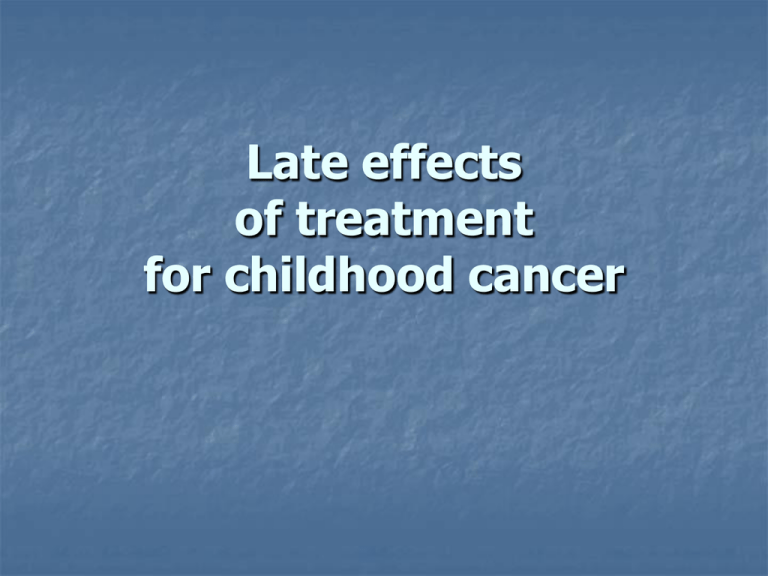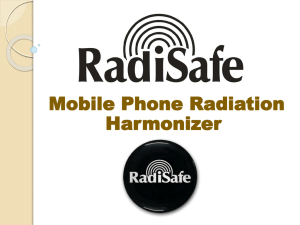
Late effects
of treatment
for childhood cancer
1950 – 1960 5 years EFS –
20%
>1990 70%
>200080%
Approximately 1 of every 640 individuals
in US between ages of 20 and 39 years
is survivor of childhood cancer
10 cancer survivors/100,000 healthy children/year
Children Cancer Survivor Study
(CCSS)
>20,000 survivors at least 5 years, treated from 1970 to
1986 (CCSS)
- standarized mortality rate (SMR)
=10,8
SMR higher in women
SMR higher in survivors treated <5years of age
SMR highest in children treated for:
CNS tumors and acute leukemias
Causes of death
Cancer recurrence/ second neoplasm
SMR =19.4
Pulmotoxicity
SMR = 9.2
Cardiotoxicity
SMR = 8.2
infections
Secondary malignancy
Standarized incidence ratio (SIR) is 6.38
for the largest observed excesses for
bone (SIR=19.1)
and breast cancer (SIR=16.2)
a 10-fold - for subsequent CNS cancer and thyroid
cancer
The cumulative incidence of SMN 20 years from the
time of original cancer diagnosis is 3.2% overall and
varied by diagnostic subgroups:
- Hodgkin lymphoma
- 7.6%
- soft-tissue sarcoma
- 4.0%
- bone sarcoma
- 3.3%
Risk factors:
Primary neoplasm (retinoblastoma, HL, STS)
Younger age at the time of therapy
Female sex
Radiotherapy
Chemotherapy
(alkylating agents, topoizomerase inhibitors)
Genetic predisposition ( Li-Fraumeni syndrome, NF t.1,
Fanconi anemia, gene polimorphisme)
enviroment
Hodgkin lymphoma >ALL, ANLL, CML,
bone tumors, thyroid cancer, breast/ skin cancer
Retinoblastoma > osteosarcoma
Nephroblastoma (genetic form) >osteochondroma,
adenocarcinoma
T-ALL > ANLL
Radiotherapy > osteosarcoma, STS, skin cancer
Radiotherapy of neck > thyroid cancer
Management
Patient education
Detailed history, including family history
Careful clinical examination
Advice on reduction risk behaviours,
especially smoking and sunbathing
Circulatory system
Anthracyclines (doxorubicin, daunorubicin, idarubicin,
epirubicin, mitoxantrone) , cyclophosphamide
- myocytes damage due to free radicals generation
Thoracic radiation therapy
- affected fine vasculature of the heart
The risks to the heart are related to:
- Cumulative anthracycline dose:
>200-300mg/m2
>600mg/m2 > 30%
500- 600mg/m2 > 11%
- method of administration (bolus)
- younger age (<15years of age)
- female sex
- trisomy 21
and in addition:
-
hypothyroidism
- ovarian failure
obesity
- renal failure
hyperlipidemia
- pulmonary failure
pregnancy
- cong.heart disease
growth hormone therapy
sex steroid replacement therapy
Cardiomyopathy
Early:
at the time of treatment to 1 year after the treatment
Late:
> 1 year after treatment
Thoracic radiation therapy >15Gy
Delayed pericarditis
Pancarditis, which includes pericardial and myocardial
fibrosis, with or without endocardial fibroelastosis
Myopathy
Coronary artery disease (CAD)
Functional valve injury
Conduction defects
Signs and symptoms
Cardiomyopathy (after chemotherapy):
Valvular damage (after radiation therapy >40Gy):
fatigue, cough,dyspnea on exertion, peripheral edema,
hypertension, tachypnea/rales, tachycardia, cardiomegaly, syncope,
palpitations, arrhytmias
weakness,cough, dyspnea on exertion, new murmur
Pericardial damage ( radiation >35 Gy) :
Coronary artery disease (radiation > 30Gy):
fatigue, dyspnea on exertion, chest pain, cyanosis, ascites,
peripheral edema, hypotension, friction rub, muffled heart sounds,
venous distension, pulsus paradoxus
chest pain on exertion, dyspnea, diaphoresis, pallor, arrhytmias
Diagnosis
Electrocardiogram (ST-T changes voltage, decreased
voltage)
Chest x-ray
Holter monitoring
Exercise testing baseline
Echocardiogram
( lower % EF, shortening fraction <28%, higher afterload)
Indications
Abnormal clinical examination & abnormal
echocardiogram & planning sport & before pregnancy :
->cardiologist consultation
Treatment
-
angiotensin converting enzyme inhibitors
cardiac transplantation
Respitatory system
Radiation therapy >15 Gy
(whole lungs, mediastinal, mantle, TBI):
Pneumonitis acute (>40 Gy alone
- or lower dose + dactynomycin/ anthracyclines )
signs: fever, congestion, cough, dyspnea
12 – 14 Gy – reduced total lung capacity and vital
capacity to about 70%
Pulmonary fibrotic disease with permanent restrictive
disease
Chemotherapy:
- Bleomycine >200mg/m2
- busulphan
- Lomustine, carmustine, cyclophosphamide
Signs and symptoms
Fatigue
Cough
dyspnea on exertion
reduced exercise tolerance
Orthopnea
Cyanosis
finger clubbing
Rale
cor pulmonare
Screening and diagnostic tests
Baseline chest x-ray
O2 saturation
Pulmonary function test
Management and intervention
Advice against smoking
Pneumococcal immunisation
Annual influenze immunisation in patients with
etablished lung disease
Urinary system
Renal failure due to:
Disease: nephroblastoma, NHL, leukemia >
> renal infiltration
> blood vessels compression
> hypertension
Chemotherapy:
Cisplatin ,carboplatin
-> glomerular dysfunction
- Asymptomatic or fatigue, anemia, oliguria
cisplatin, carbo, ifosfamide -> tubular dysfunction
- seizures (low Magnesium!), weakness (low PO4),
glikozuria, poor linear growth
ifosfamide -> glomerular and tubular toxicity with renal
acidosis and Fanconi’s syndrome
cyclophosphamide, ifosfamid ->hemorrhagic cystitis
- Hematuria, dysuria
Radiotherapy
Doses > 25 Gy to both kidneys > renal failure at
delayed intervals of more than 6 months
Radiation 20 – 30 Gy or 10- 15 Gy with
chemotherapy >
- hypoplastic kidney/ renal arteriosclerosis:
*fatigue, poor linear growth, hypertension,
headache, edema, albuminuria
- nephrotic syndrome
* proteinuria, edema
- bladder: fibrosis or hypoplasia (reduced bladder
capacity)
*urgency, frequency, incontinence (nocturia), pelvic
hypoplasia
- bladder tenderness
*urinary tract infections, renal calculi
Management and intervention
In dependence of late effect:
Glomerular dysfunction, hypoplastic kidney
- low-protein diet, dialysis, renal transplant
Tubular dysfunction
- Mg supplement, PO4 supplement
Nephrotic syndrome
- low salt diet, diuretics
Gastrointestinal tract
Enteritis due to:
Chemotherapy (actinomycin D, doxorubicin)
Radiation >40Gy
Surgery (abdominal surgery enchance RT effect)
- abdominal pain
- diarrhea, decreased stool bulk
- emesis
- weigth loss, poor linear growth
Adhesions due to:
Radiation
Surgery
-abdominal pain
- bilious vomiting
- hyperactive bowel sounds
Indications:
* abdominal radiograph
* adhesion lysis
Fibrosis esophagus (stricture) due to:
Chemotherapy (actinomycine D, doxorubicine)
Radiation >50 –50 Gy
Abdominal surgery
- weight loss
- dysphagia
- poor linear growth
Indications:
* esophagus dilatation
* Antireflux therapy
Fibrosis small intestine due to:
Radiation > 40 Gy
Abdominal surgery
- diarrhea
- weight loss
- obstruction
- abdominal pain
- constipation
Indications:
*high –fiber diet
*decompression, resection, balloon dilatation
Large intestine/ colon fibrosis due to:
Radiation >40 Gy
Abdominal surgery
Signs:
- abdominal colic
- rectal pain
- constipation
- melena
- weight loss
- obstruction
Indications:
* stool softeners, high-fiber diet
Hepatic late effects
Fibrosis/ cirrhosis due to:
Chemotherapy ( mtx, act D, 6-MP, 6-TG)
Radiation >30 Gy
Surgery
Hepatitis B/C infection
Endocrine system
Thyroid late effects
Overt hypothyroidism
- radiation >20 Gy to the neck, cervical spine
- TBI
- partial or total thyroidectomy
Symptoms:
hoarseness, fatigue, weight gain, cold intolerance, dry
brittle hairs, alopecia, constipation, lethargy, pubertal
delay, bradycardia, hypotension
Diagnosis: T4, TSH
Compensated hypothyroidism- asymptomatic
Hyperthyroidism –nervousness, tremor, heat
intolerance, weight loss,increased apppetite, insomnia,
diarrhea, moist skin, goiter
Thyroid nodules – any dose radiation
hoarseness, fatigue, dry skin, cold intolerance, dry
brittle hair, alopecia, constipation, lethargy, poor linear
growth
Biopsy!
Neuroendocrine late effects
GH deficiency
- Radiation >24 Gy
- Surgery (tumor in region of H-P axis)
Adrenocorticotropic hormone deficiency
- Radiation >40 Gy/ surgery
Thyrotropin-releasing hormone deficiency
- Radiation > 40 Gy
Precocious puberty
- Radiation >20 Gy
Gonadotropin deficiency
- Radiation >40 Gy/ surgery
Hyperprolactinemia
- Radiation >40 Gy/surgery
Metabolic syndrome:
(insulin resistance, hyperglycemia, hyperinsulinemia,
hypertension, hyperlipidemia, obesity):
- steroids
- radiation ? >18 Gy
Musculoskeletal system
Radiation therapy> 20 Gy :
> soft tissue hypoplasia
> assymmetry of muscle mass when compared with
untreated area,decreased range of motion, stiffness and
pain in affected area
> spinal abnormalities : scoliosis, kyfosis, lordosis,
decreased sitting height
> back pain, hip pain, uneven shoulder height, rib
humps or flares, deviation from vertical curve, gait
abnormalities
diminution of bone growth
> lenght discrepancy:
lower back pain, limp,hip pain, discrepancy in muscle
mass and length when compared with untreated
extremity, scoliosis
> pathological fracture
>osteonecrosis (steroids, radiation >40Gy):
pain in affected joint, limp
>osteopenia/ osteoporosis (steroids,radiation >18 Gy)
Obesity
Risk factors:
Female survivors
ALL
CNS radiation
Steroids
Cranial irradiation
Genetic predisposition
Polimorphism in the leptin receptor gene
Brain tumors (hypothalamic dysfunction)
Reproductive system
Male gonadal function:
Germ cell damage (oligospermia/azoospermia)
Chemotherapy: cyclophosphamide, lomustine,
carmustine, procarbazine, ifosfamide, busulfan,
melphalan,dacarbazine
Radiation >1 Gy
Surgery (orchiectomy or surgical manipulation)
* Symptoms: testicular atrophy
* Diagnosis: FSH, inhibin B, spermiogram
* Management: sperm banking prior to treatment
Leydig cell damage:
Chemotherapy: cyclophosphamide, etoposide
Radiation> 12 Gy to the testes or scattered from pelvis
Surgery: orchiectomy
*Symptoms: delayed/arrested/absent pubertal
development, lack of penile and testicular enlargement,
voice change, body odor and acne, testicular atrophy
* Diagnosis: LH, testosterone
* Management: testosterone replacement regarding
testosterone deficiency
Female gonadal late effects
Ovarian failure:
Chemotherapy (cyclophosphamide,procarbazine,
busulfan,melphalan, dacarbazine, carmustine,
ifosfamide)
Radiation >4 Gy
Surgery: oophorectomy or oophoropexy
*Symptoms: delayed/arrested pubertal development
(breasts, female habitus, menses, estrogen deficiency,
infertility), osteoporosis, atherosclerosis
*Diagnosis: LH,FSH, inhibin B, anti-mullerian hormone
*Management: hormone replacement
Vagina: fibrosis/diminished growth
Chemo: act D, doxo – enhance radiation therapy effect
Radiation >40Gy
Uterus:
Radiation >20 Gy (prepubertal), >40 Gy (pubertal)
*Symptoms: spontaneous abortions, low birth-weight
infants, small uterus
*Diagnosis: usg
Growth impairment
Brain tumors (craniopharyngioma)
Cranial radiotherapy > GH deficiency (>24 Gy)
LH/ FSH/ ACTH/ TSH deficiency (>40 Gy)
Spinal irradiation > spinal growth is affected > skeletal
disproportion
Radiation directed on the gonads
TBI
Precocious puberty after cranial irradiation
Chemotherapy, steroids
Monitoring for growth problems
Regular height measurement
Endocrinologist consultation
Treatment with growth hormone
-
-
Craniopharyngioma
After cranial iradiation (acute leukemia)
– possibility of cancer recurrence???
- second cancers?
CNS late effects
Neurocognitive deficits
(after radiation >18Gy, HD MTX)
-difficulty with: reading, language, memory, attention,
decreased IQ, poor school attendance, poor hand-eye
coordination
Leuko-encephalopathy
(MTX, Ara-C, radiation >18 Gy) -seizures, neurologic
impairment
Focal necrosis
(MTX,cisplatin, carmustine, radiation >50 Gy)
-headaches, seizures, papilledema, hemiparesis,
speech/learning/memory deficits
Large vessel stroke (radiation >50 Gy)
-headache, seizures, hemiparesis, aphasia, focal
neurologic findings
Vision loss (cisplatin, radiation >50 Gy, surgery)
-progressive visual loss
Ototoxicity (cisplatin, carboplatin, radiation >35 Gy,
surgery)
- abnormal speech development, hearning
Myelitis (radiation >45 Gy, surgery)
-paresis, spasticity, altered sensation, loss of sphincter
control
Ear late effects
Chronic otitis (radiation >35 Gy)
Sensorineural hearing loss (cisplatin, carboplatin,
radiation >40 Gy)
Decreased production of cerumen (radiation >30 Gy)
Chondritis ( radiation 50 Gy)
Chondronecrosis (radiation 60 Gy)
Eye late effects
Radiation >50 Gy:
Decreased tear production
Lacrimal duct fibrosis
Ulceration of eyelids
Conjunctiva: necrosis, scarring
Thinning of aclera
Cornea ulceration
Neovascularization
keratinization
Cataract
Secondary glaucoma
Iris neovascularization
Retina:
infarction, exudates, hemorrhage, teleangiectasia,
neovascularization, macular edema, optic neuropathy
Dental late effects
Xerostomia (decreased salivary gland function)
radiation >40 gy
Abnormal tooth and root development due to
radiation >10 Gy and chemotherapy
due to







